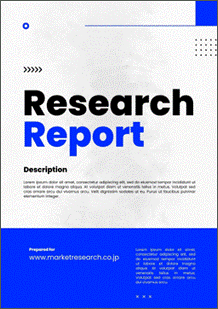 | • レポートコード:MRC2108A521 • 出版社/出版日:Mordor Intelligence / 2021年7月 • レポート形態:英文、PDF、96ページ • 納品方法:Eメール(受注後2-3営業日) • 産業分類:エネルギー・電力 |
| Single User | ¥481,000 (USD3,250) | ▷ お問い合わせ |
| Team User | ¥555,000 (USD3,750) | ▷ お問い合わせ |
| Corporate License | ¥962,000 (USD6,500) | ▷ お問い合わせ |
• お支払方法:銀行振込(納品後、ご請求書送付)
レポート概要
| Mordor Intelligence社は、高電圧直流(HVDC)送電システムの日本市場規模が2020年177.79百万ドルから2026年150.06百万ドルまで、2021年から2026年の間に年平均6.51%成長すると予測しています。本調査資料では、日本の高電圧直流(HVDC)送電システム市場について調査し、イントロダクション、調査手法、エグゼクティブサマリー、市場概要、種類別分析、コンポーネント別分析、競争状況、市場機会/将来の見通しなどを掲載しています。 |
The Japan High Voltage Direct Current (HVDC) transmission systems market is estimated to be USD 177.79 million in 2020, and it is expected to reach USD 150.06 million by 2026, at a CAGR of 6.51% during 2021-2026. The market was relatively stable from the impact of COVID-19, and it did not witness any significant delays, despite the supply chain disruptions. The major factors driving the market include increasing penetration of renewable energy and policies for increasing investments and efficiency of the transmission system. However, due to the growing adoption of distributed and remote power systems in the country, the demand for HVDC transmission systems is expected to experience a restraint.
- The underground and submarine HVDC transmission system segment is expected to account for the largest share in the Japanese HVDC transmission systems market in terms of transmission type. This is primarily due to the several projects for connecting different islands with HVDC transmission systems owing to several preferable properties, such as low power loss and safety from natural calamities.
- In terms of components, the converter stations segment held the largest share of the market studied. Factors such as increasing demand for bulk power transmission, increasing penetration of HVDC and connecting AC line to DC line for efficient transmission lead to the increased demand for converter stations.
- Japan is undergoing a significant energy transition and is shifting away from fossil fuels. The increasing penetration of renewable energy, especially offshore wind, and solar energy, is expected to drive the market’s growth in Japan. In 2020, the government of Japan announced its plan to install 45 GW of offshore wind power in the country by 2040, which foreshadows the increase in demand for subsea transmission lines.
Key Market Trends
Increasing Demand for Underground and Submarine HVDC Transmission Systems
- The submarine transmission of electricity is gaining importance on account of increasing focus on renewable energy, such as wind energy, and power trading with neighboring countries.
- The HVDC submarine power transmission system is considered a key technology for the development of future power transmission networks.
- It is also the only solution available for the transfer of high power across long subsea distances. For these reasons, HVDC lines are preferred for interconnecting offshore wind plants worldwide including the upcoming offshore wind projects in Japan.
- Moreover, for subsea transmission, the HVAC transmission line due to technical constraints such as induced capacitance leads to huge power losses; therefore, submarine power transmission mostly uses HVDC for power transmission.
- Therefore, factors, such as the increasing number of offshore wind farms, along with inter-connections between countries and islands through submarine cables, are expected to increase the demand for submarine transmission systems over the forecast period.
The Growing Renewable Energy Sector is Driving the Market Demand
- The development of renewable energy is a trend in the current scenario. Most of the renewable installed capacity is located far away from the load centers. HVDC is essential for remote projects, as cable lengths of approximately 80 km or more usually require HVDC transmission technology.
- As the HVDC lines are better suited for long-distance power transmission, power transmission companies are increasingly using HVDC over HVAC transmission lines, to integrate the renewable power capacity.
- Moreover, the cost of renewable power generation is continuously declining. The economics of renewables has improved dramatically, with both wind and solar. The major reasons behind the falling generation costs are innovations in the manufacturing and installation of PV power generation, improvement in wind turbine materials and designs, intense competition, and economies of scale.
- Due to lower costs, the renewable energy sector is becoming competitive and, in some cases, cheaper than conventional power plants. Furthermore, for the development of wind capacity in Hokkaido, Honshu, and Kyushu, Japan plans to double its inter-regional power grid capacity of 24 GW (as of 2020) by adding 23 GW of new transmission lines.
- The demand for reliable power supply and the distance between energy demand center and power generation center, along with growing renewable energy generation capability of the nation, may drive the market demand for HVDC transmission systems in the coming years.
Competitive Landscape
The market for high voltage direct current (HVDC) transmission systems in Japan is moderately consolidated. Some of the major players in this market include Hitachi ABB Power Grids, Sumitomo Electric Industries Ltd, Toshiba Corporation, and Mitsubishi Electric Corporation.
Reasons to Purchase this report:
- The market estimate (ME) sheet in Excel format
- 3 months of analyst support
1 INTRODUCTION
1.1 Scope of the Study
1.2 Market Definition
1.3 Study Assumptions
2 RESEARCH METHODOLOGY
3 EXECUTIVE SUMMARY
4 MARKET OVERVIEW
4.1 Introduction
4.2 Market Size and Demand Forecast, in USD billion, till 2026
4.3 Recent Trends and Developments
4.4 Government Policies and Regulations
4.5 Market Dynamics
4.5.1 Drivers
4.5.2 Restraints
4.6 Supply Chain Analysis
4.7 PESTLE ANALYSIS
5 MARKET SEGMENTATION
5.1 Transmission Type
5.1.1 HVDC Overhead Transmission System
5.1.2 HVDC Underground and Submarine Transmission System
5.2 Component
5.2.1 Converter Stations
5.2.2 Transmission Medium (Cables)
6 COMPETITIVE LANDSCAPE
6.1 Mergers and Acquisitions, Joint Ventures, Collaborations, and Agreements
6.2 Strategies Adopted by Leading Players
6.3 Company Profiles
6.3.1 Hitachi ABB Power Grids
6.3.2 Mitsubishi Electric Corporation
6.3.3 Toshiba Corporation
6.3.4 Sumitomo Electric Industries Ltd
6.4 Market Player Ranking
7 MARKET OPPORTUNITIES AND FUTURE TRENDS